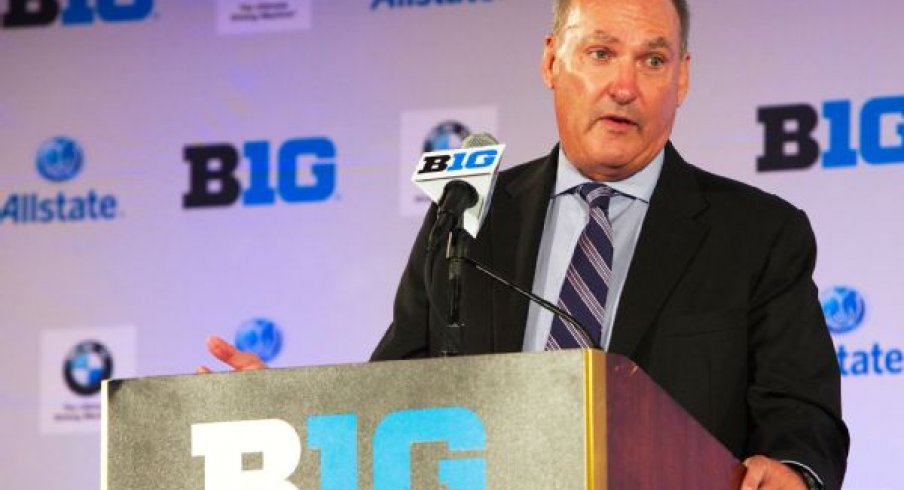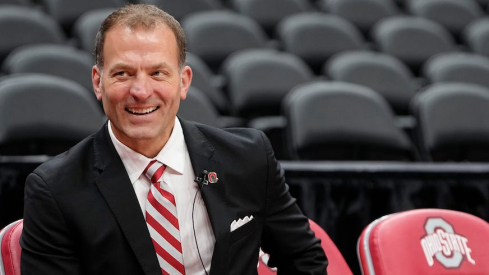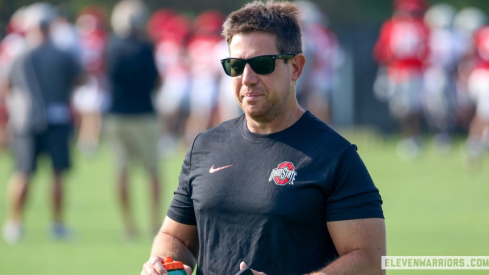Tradition is ever evolving for the Big Ten, the oldest Division I collegiate athletic conference. This evolution has seen the expansion of the conference from the Midwest to the East Coast with four programs not affiliated with the conference since its expansion to the numerically correct "Big Ten" with Michigan State in 1950.
It has also seen the evolution of the conference from the country's elite to a national punchline for the past ten years. Previously the testing ground for the spread offense and home to the best defenses in college football, the Big Ten last had a winning bowl record in 2009 (4-3) and last won the trophy given to the conference with the best bowl record in 2002.
Things are no better this season. The Big Ten is 1-10 against the ACC/Notre Dame, SEC, Big XII, and Pac-12. It also has three losses on record to MAC schools. It's effectively eliminated from consideration for the first College Football Playoff after just two weeks into the season.
Ohio State's two-touchdown home loss to Virginia Tech, Michigan's shutout loss to Notre Dame, and Michigan State's loss at Oregon all highlighted the Week 2 conversations about the low quality of Big Ten football. While embarrasing, the losses says less about the Big Ten and more about the individual programs. Ohio State had a youth movement made a nightmare by bad game-planning, Michigan State ordered a big meal at then-no. 3 Oregon and could not finish it. Michigan's shutout loss is a bigger issue for Brady Hoke's job security than an issue about the conference.
Commentary about the Big Ten's quality should not focus on the conference's perennial favorites. At least they're trying and Penn State will be back to full form starting next year. Conversations about the Big Ten's poor quality should focus on "traditional" mid-to-bottom tier programs. In the past 20 years, Illinois went from January bowl team to a joke. Iowa went from three top-ten finishes to a team that can't reliably beat Iowa State. Purdue went from a Big Ten champion Rose Bowl squad quarterbacked by Drew Brees to a team playing football on par with bad Ivy League schools. A similar comment could be given to Nebraska, which won three national championships in the 1990s and now struggles to beat McNeese State.
Meanwhile, similar cellar-dwellars in the SEC are raiding the Big Ten's geographic footprint for talent to bring south to the SEC. At this rate, the overall quality of the conference will not improve for the foreseeable future.
I offer some comments about ways to improve the Big Ten's quality of football. However, few fixes can be top-down. While I am sympathetic with (and would support) Ramzy's proposal to institute a B1G "Suck Tax" at the conference-level, this type of "stick" to balance out the conference's carrots would not be a completely credible threat unless the losses could put targeted programs in the red. Ultimately, the initiative needs to be taken at the program-level to become better at the sport in order for the conference as a whole to improve.
The Importance of a Great Support Staff
The University of Illinois has 16 total staff members for football, ten of which are coaches (including Tim Beckman, head coach). Alabama has 29 total staff members, including its head coach and assistant coaches. The importance of this discrepancy may not be obvious, but Alabama has 13 more staff members than Illinois just to deal with behind-the-scenes stuff so Nick Saban and his assistants can focus on winning football games.
The reader would be mistaken to believe Alabama is side-skirting NCAA rules. The NCAA limits the coaching staff, but not the support staff. Alabama, like any other program, is limited to one head coach, nine assistant coaches, two graduate assistants, and a strength coach. The NCAA has taken a hands-off approach to any other staff member. It's the program's discretion to hire anyone they want behind the scenes provided those other staff members aren't giving marching orders to a football player during a practice or engaging in some form of coaching during a game. That's not to say Alabama hasn't flaunted this in front of the NCAA, but that's a different story.
Most programs that have expanded their support staffs in recent years have done so with recruiting in mind. Ohio State has 11 support staff members, most of whom deal with things related to recruiting. Alabama's approach is a bit more novel. Alabama has eight members on its support staff listed as just a "football analyst". The job description may vary from person-to-person, but Nick Saban has eight members on staff whose job is to watch football tapes to help recruit new talent or scout opponents.
If fans want to understand how Nick Saban could go from a good coach at LSU to a phenomenal coach at Alabama after a failed stint in the NFL, this is your answer. Nick Saban brought with him the administrative professionalization of college football from his short time in the NFL.
This is quite clever and more Big Ten programs should embrace it rather than give a dismissive attitude articulated by Purdue's athletic director to ESPN's Adam Rittenberg.
If Purdue's football program has a true need, Burke said he's willing to fund it. But adding staff simply to review video, along with supervisory positions, creates a "bureaucracy."
"The reality is probably nine out of every 10 kids [on video] can't play at this level," Burke said. "But because everybody else is doing it, I better check because I might find a diamond in the rough. Well, if that diamond in the rough costs you five or six positions, and you're sitting there all day looking at video, does that necessarily mean your football team's going to be better? I don't know."
This misses the point and it's borderline defeatist.
Nick Saban has eight members on his support staff who watch video to find new talent so Nick Saban can focus on something else (like talking with the recruits his staff deems a five-star talent). Nick Saban has eight "football analysts" on staff who can watch West Virginia's 2013 season and 2014 spring game to discern patterns months before the Crimson Tide played the Mountaineers in Atlanta. He has eight "football analysts" on staff that can keep track of LSU and Auburn before those big games later this season.
All the while, Saban has more time to recruit five-star talents. He also has more time to focus on particulars because his support staff has done important brush-clearing work for him about future opponents. He may even have more time to keep his sanity amid an insatiable appetite for winning.
It's not about "creating a bureaucracy" [...] It's about giving the football coaches necessary support when resources (i.e. time and energy) are scarce.
It's not about "creating a bureaucracy", per Purdue's athletic director. It's about giving the football coaches necessary support when resources (i.e. time and energy) are scarce. Programs like Illinois and Purdue may have one or two GAs tasked with doing scouting. Alabama has a scouting department.
Creating this "bureaucracy" would not be a monumental undertaking. Several of Alabama's football analysts were former players for Nick Saban at Michigan State (Dean Altobelli) or Alabama (Wes Neighbors, William Vlachos). Programs like Illinois and Purdue no doubt produce dozens of football alumni with no chance at the NFL that would otherwise like to continue being involved in the game. Football alumni or local high school coaches long since retired may still want to contribute to improving the local program without having to go through the rigors of recruiting and roster management. Give them the opportunity.
Some of these guys at Alabama make between $30,000-$40,000 a year. In short, this could be a relatively inexpensive use of the BTN money that programs like Purdue receive and could be made cheaper by providing even a quarter of what Alabama provides Nick Saban.
The benefits could still be substantial.
Recruiting, Recruiting, Recruiting
Recruiting is the life blood of any college athletics program. Right now, the problem isn't that the lower-tier Big Ten teams can't find good FBS prospects. It can't find enough of them and convince them to come to places like Iowa City, Lincoln, Minneapolis, or West Lafayette. These are all great college towns or cities that should be able to sell themselves.
Addressing this is trickier. Recruiting is still regional. Programs in the Big Ten compete, or should be competing, for the same prospects. The recruiting good in the Big Ten is ultimately rivalrous.
While recruiting disparities exist within the Big Ten, the more immediate problem is the incursion from the South. I mentioned this earlier this year, calling it the Big Ten's "Kentucky Problem". Programs like Michigan State and Wisconsin accustomed to getting the second-tier prospects from Ohio are now losing those recruits to Kentucky and Tennessee. Kentucky's football program, which finally discovered how close it is to talent-rich Ohio, is using the lure of SEC football to lure Ohioans from the Buckeye State without signature offers from Michigan, Notre Dame, or Ohio State. Though Notre Dame is not in the Big Ten, its presence in the Big Ten's geographic footprint is a fact of life for programs in the Big Ten and always has been.
Programs hoping to compete in the Big Ten with the conference's traditional elite should not permit this talent exodus to happen. Ohio and Western Pennsylvania should be high priority for any team in the conference.
The more intriguing talent exodus is happening in Illinois and the Chicagoland area in particular. Chicago is tough to recruit for any upstart program in the Big Ten, which is precisely the type of program that needs to improve if the conference is to improve as a whole. Chicago is a gateway. Cheap flights can carry prospects to programs across the country. Further, Chicago is a few hours drive to traditional powers like Michigan and Ohio State, as well as Notre Dame.
Given their locations to Chicago, programs like Iowa, Illinois, Northwestern, Indiana, and Purdue need as many Illinois (and, in particular, Chicagoland) prospects as they can get. The results from the recruiting trail have been grim in the past few years.
Iowa, whose glory years a decade ago were built on Illinois prospects, did not sign a top 50 prospect from Illinois last year. It got just two of the top 50 prospects in 2013.
Illinois, got one top 25 prospect from its own state last year and just three the year before.
Indiana and Purdue combined for seven of the top 50 in the past two recruiting classes, none higher than a no. 17 prospect in the state (Nile Sykes, who signed with Indiana in 2014).
Meanwhile, suitors are coming from far and wide to Chicago. LSU signed the no. 1 Illinois prospect in 2014 and the no. 3 Illinois prospect in 2013. Ole Miss signed the no. 1 Illinois prospect in 2013. That prospect, Laquon Treadwell, would be a starting wide receiver on any program in the country. Tennessee signed the no. 4 and no. 8 prospects in Illinois last year. USC signed the no. 2 prospect in 2013, though he just transferred to Michigan. Missouri and Vanderbilt recruited better prospects from Illinois than Illinois.
Though "recruit better" is a platitude, it's still worth reiterating. The Big Ten needs more Mark Pantonis in the support staff to serve as ace recruiters for head coaches so head coaches can focus on other priorities. Rather than remark how effective Pantoni is in his role, other programs should follow suit.
Michigan State went this route in hiring the well-regarded Curtis Blackwell for a similar role on Mark Dantonio's staff. Blackwell is the guy behind the Sound Mind Sound Body camps and may well help Michigan State turn the tide on in-state Michigan in recruiting the Detroit area.
Basically, it's unfathomable that no one in the Big Ten has thought to hire someone behind the Core 6 Athletes Showcase to better recruit Illinois. They're almost all Big Ten guys.
I think there are two additional strategies that low-to-mid tier teams in the Big Ten should consider in order to raise its talent level. Programs like Iowa that may feel handicapped by geography should think of following Kansas State's suit: recruit more JUCO prospects. Iowa, also home to one of the top JUCO programs in the country, has no excuse to not consider this route. To his credit, Tim Beckman's recent stategy of recruiting JUCO players has paid dividends with guys like Martize Barr, Geronimo Allen, and Jihad Ward. Programs finding it difficult to recruit top prospects from high school should find it comforting that JUCO prospects can and will go anywhere.
On a related note, some Big Ten programs may want to consider a push west into California. The inclination may be to instead look south to places like Georgia, Florida, and Texas. While the area is rich with talent, it is also dense with major college football programs from the Big XII, the SEC, and the ACC. Kids from these states have several college football choices, all without having to travel far from the region.
California is more disperse, all things considered. A Southern California prospect without an offer from UCLA or USC may still have to drive five hours to Tempe to play for Arizona State or fly three hours (or drive a day and a half) to Seattle to play for Washington. A solid high three-star or low four-star prospect from California without a good Pac-12 offer is left with undesirable options like Fresno State or Nevada. This hypothetical recruit is comparable to the second-tier Ohioan that Big Ten programs are losing to Kentucky and Tennessee. That player should instead come to the Big Ten.
Oklahoma has already figured this out, getting four-star prospects from the Bay Area, San Diego, and the Central Valley to come to Norman. Nebraska has made it a priority as well. Others may want to follow suit.
Like JUCO prospects, California prospects can and will travel since they sometimes have little recourse in order to play college football. That should be a recruiting pitch for several Big Ten programs looking to add talent to the roster but striking out in Ohio and Illinois.
Having a dedicated recruiting staff can make it an easier sell.
It's Ultimately the Initiative of Each Program
Few initiatives to fix Big Ten football can come from the top-down. An academic consortium at its core, expulsion or relegation is not a credible threat. A "Suck Tax" (which I still think the conference should do) is a less than credible threat unless the assessed penalty could put targeted programs in the red.
Fans hoping Jim Delany could slam the quality of the conference in order to shame it to improve are mistaken as well. It would be myopic for Jim Delany to affirm "yeah, we suck" while trying to negotiate lucrative TV contracts for the league as a whole. He's still "in it to win it" because he has no other option.
Fixing the quality of Big Ten football is the individual initiative of each athletic director (or, in the curious case of Iowa, Kirk Ferentz). Each program gets north of $20 million annually from Big Ten Network revenue, ostensibly to invest in promoting and improving the product. It's time to start using it, lest guys like Morgan Burke at Purdue find themselves with an unwinnable program that no one wants to pay to see.
The suggestions offered here, especially regarding support staffs, are just a start, but they reflect current trends and evolution of college football. Recent results suggest Big Ten football is anything but "current" or "evolved".


